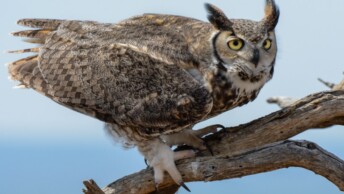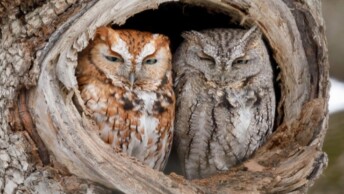Some birds carry an extra dose of charm, with round shapes, large eyes, fluffy feathers, and playful habits that make them irresistibly endearing. From tiny tits and robins to wide-eyed owls and waddling penguins, these species win affection as much for their personalities as for their beauty.
Long-Tailed Tit
Aegithalos caudatus
- Why cute: Tiny, round body, stubby bill, oversized tail, and fluffy, toy-like appearance.
- Where found: Across Europe and Asia in woodlands, hedgerows, parks, and gardens.
- Conservation status: Least Concern; common overall but vulnerable to harsh winters and local declines.
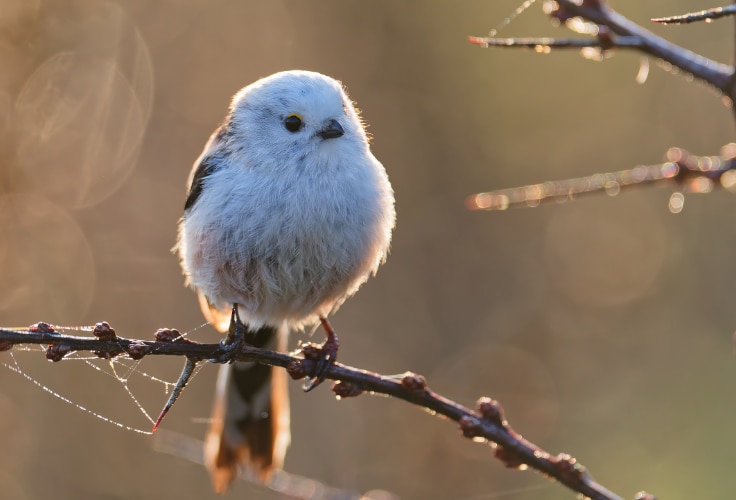
The long-tailed tit is often described as one of the cutest birds in Europe. Barely larger than a golf ball, it has a rotund, fluffy body with a tail longer than the bird itself, giving it a comically unbalanced shape. Its bright dark eyes and constantly fluffed plumage make it appear soft and toy-like, while the pinkish and white tones in its feathers add to its gentle look.
Much of the bird’s charm comes from its social behavior. These tiny birds are highly gregarious, moving in flocks that chatter noisily as they weave through trees and hedges. They roost communally on winter nights, pressing together in tight groups for warmth, which looks almost like a single ball of fluff. Their high-pitched calls, rapid movements, and habit of hanging upside down to pluck insects only increase their charm.
The species is found throughout Europe and Asia, where it occupies deciduous and mixed woodlands, hedgerows, suburban parks, and gardens. It remains common across most of its range, though numbers can crash after severe winters, sometimes taking years to recover. Local declines are also linked to modern forestry and predation, but overall it remains secure.
Black-Capped Chickadee
Poecile atricapillus
- Why cute: Tiny, round body with oversized head, bold cap and cheeks, and curious, friendly demeanor.
- Where found: Across northern U.S. and Canada in deciduous and mixed woodlands, thickets, parks, and backyards.
- Conservation status: Least Concern; common and stable overall, with local declines offset by increases elsewhere.
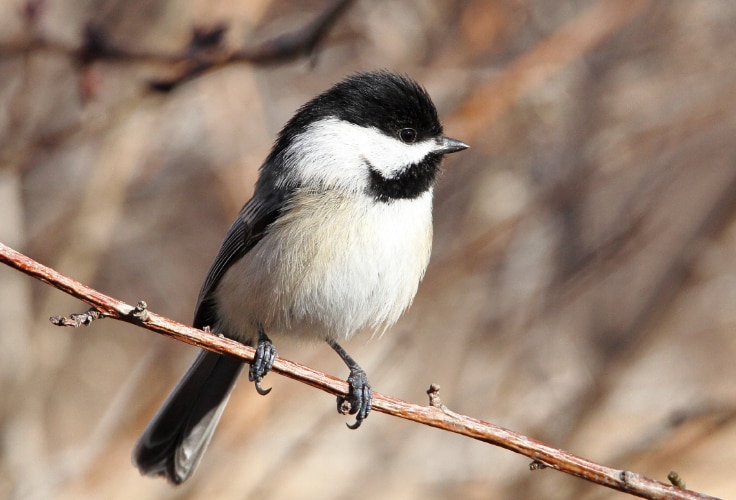
Few North American birds look as endearing as the black-capped chickadee. Its soft, plump body is topped with a large round head, set off by a neat black cap and throat patch that frame gleaming white cheeks. Add the buff wash along its sides, a short stubby bill, and expressive dark eyes, and the result is a bird that seems both approachable and full of character.
Personality adds to its appeal. Chickadees are famously bold and inquisitive, often approaching people with little hesitation. They forage with lively hops and agile flips, clinging upside down to snatch insects or seeds, and rarely sit still. Flocks keep up a lively chatter, with their namesake “chick-a-dee-dee-dee” call doubling as an alarm system where the number of notes signals the level of danger. Their blend of energy, sociability, and intelligence makes them charming companions in woodlands and gardens alike.
Its range stretches across most of Canada and the northern United States, from Alaska and the Great Plains to the Northeast and Appalachians. It thrives in mixed forests, edge habitats, willow thickets, suburban parks, and backyards, adapting well to human presence. Overall numbers are stable, with gains in the east balancing local declines in the west. While the species depends on cavity trees for nesting and can suffer where dead wood is removed, it benefits from forest edges and bird feeders, remaining one of the most familiar small songbirds of the region.
Atlantic Puffin
Fratercula arctica
- Why cute: Chunky, round body, comical waddle, and oversized multicolored bill that gives it a clown-like look.
- Where found: Rocky islands and cliffs across the North Atlantic; winters far offshore at sea.
- Conservation status: Vulnerable; still abundant but declining in parts of its range due to climate-driven changes in food supply.

The Atlantic puffin is instantly recognizable and often nicknamed the “clown of the sea.” Its plump black-and-white body, short wings, and upright stance create a toy-like silhouette, while its massive triangular bill, painted in vivid red, orange, and yellow during breeding season, adds a comical touch. With orange legs and a teetering gait, it looks like a seabird dressed for the stage.
On land, puffins waddle and bow, signaling peaceful intent as they shuffle through crowded colonies. They court by rubbing bills in a gentle “kissing” gesture, and pairs often reunite at the same burrow year after year. At sea, their cuteness takes on another form: they flap furiously in the air, but underwater those same wings transform into efficient flippers, carrying them deep in pursuit of fish. Sometimes they return with a bill crammed full of sand eels, each held neatly crosswise, a sight that only adds to their appeal.
This species breeds on rocky islands and coastal cliffs across the North Atlantic, from eastern North America through Iceland and the British Isles to Norway. It spends most of the year at sea, ranging widely over cold northern waters. Puffins remain numerous, with millions still nesting in Iceland, but populations are declining in several regions. Warming seas have disrupted their food supply, leading to breeding failures, and climate change now poses the main long-term threat. Thanks to conservation work, puffins have also returned to Maine after disappearing a century ago.
Northern Saw-Whet Owl
Aegolius acadicus
- Why cute: Tiny owl with round head, catlike face, and large golden eyes set in a soft white facial disk.
- Where found: Forests across Canada, the northern U.S., and mountains of Mexico, favoring conifers and dense understory.
- Conservation status: Least Concern; widespread and fairly common, though some local declines and subspecies are of concern.
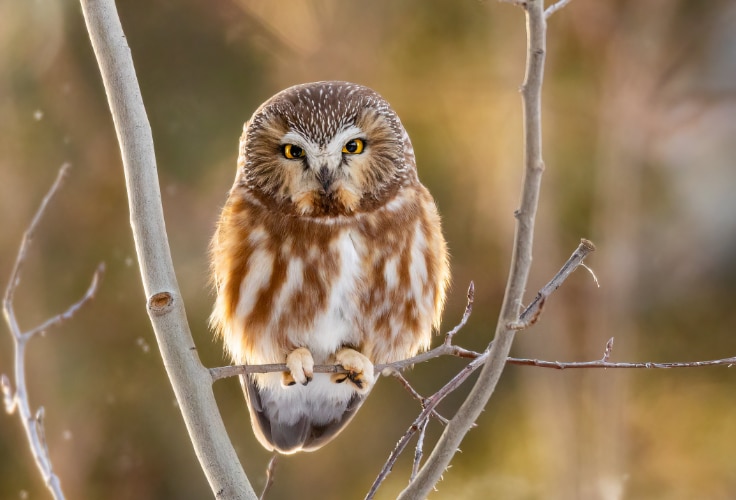
The northern saw-whet owl looks almost like a toy version of an owl. Barely larger than a sparrow, it has a compact body, short tail, and an oversized round head. Its bright yellow eyes shine against a pale facial disk, giving it an alert, almost surprised expression. With soft brown streaked plumage and heavily feathered legs, it has a plush, endearing appearance that belies its secretive habits.
Its behavior adds to the charm. Saw-whets roost quietly by day in dense conifers, often hidden just a few feet off the ground. At night, they hunt silently, flying low with bounding wingbeats and pouncing on mice with precision. Their call, a steady “too-too-too” whistle, carries through dark forests in spring, sounding almost mechanical. Despite their fierce hunting skills, their tiny size, catlike face, and occasional habit of peering curiously from foliage give them an unmistakably endearing character.
This owl is found across North America, breeding from Alaska and Canada through the northern and western United States, and south into Mexico’s mountain ranges. It favors mixed and coniferous forests with dense cover and suitable nesting cavities. Populations are stable overall, though they are often difficult to monitor due to their elusive nature. Habitat loss from logging and development poses local risks, while the isolated Haida Gwaii subspecies is considered threatened. Overall, the northern saw-whet owl remains one of the most widespread and endearing small owls of the continent.
Eurasian Wren
Troglodytes troglodytes
- Why cute: Tiny, round-bodied songbird with a stubby, cocked tail and lively, mouse-like movements.
- Where found: Across Europe, Asia, and North Africa in forests, scrub, gardens, and rocky coastal habitats.
- Conservation status: Least Concern; abundant overall, though some island subspecies are scarce or threatened.
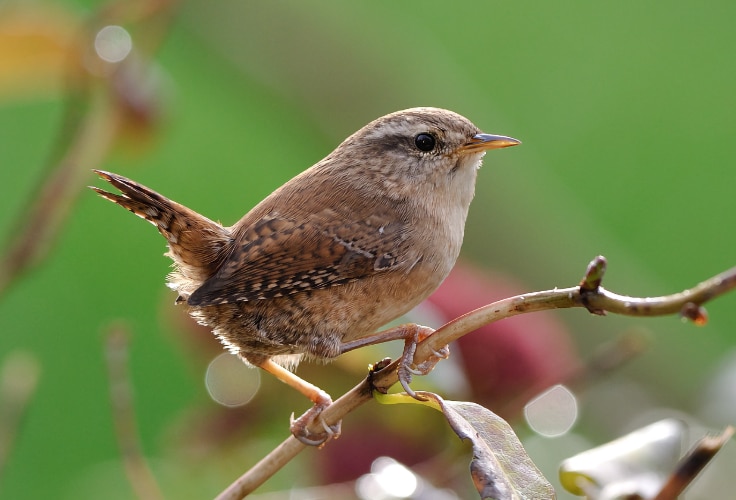
The Eurasian wren is one of Europe’s smallest birds, and its charm lies in its compact, rounded form and perky, constantly cocked tail. Its fine brown plumage is delicately barred and patterned, blending into undergrowth until it bursts into song. The large head, short wings, and soft expression give it a toy-like quality that, paired with its restless energy, make it irresistibly appealing.
Much of the species’ cuteness comes from its restless, almost mouse-like behavior. Wrens dart through brambles, stone walls, and low vegetation with quick hops and jerks, probing crevices for insects. They roost communally in winter, sometimes crowding into a single hole in groups for warmth, forming a ball of fluff hidden away in dark retreats. Males deliver a remarkably loud and musical song, a cascade of trills and warbles that seems outsized for such a small bird, adding to its captivating presence.
This wren ranges widely across Europe, much of Asia, and parts of North Africa, inhabiting woodlands, scrub, hedgerows, gardens, moorlands, and rocky coasts. It thrives in dense cover from sea level to mountain slopes and adapts readily to human landscapes. While populations are robust and the species is considered secure overall, some island races are scarce or endangered, and harsh winters can cause sharp but temporary declines. Despite these pressures, the Eurasian wren remains a familiar and abundant symbol of small-scale charm across its vast range.
Rosy-Faced Lovebird
Agapornis roseicollis
- Why cute: Small, brightly colored parrot with a rosy-pink face, big dark eyes, and playful, affectionate habits.
- Where found: Native to arid woodlands and river valleys of southwestern Africa; feral colonies also established in Arizona and Hawaii.
- Conservation status: Least Concern; locally diminished by trapping but still common in parts of its range and popular as a pet.
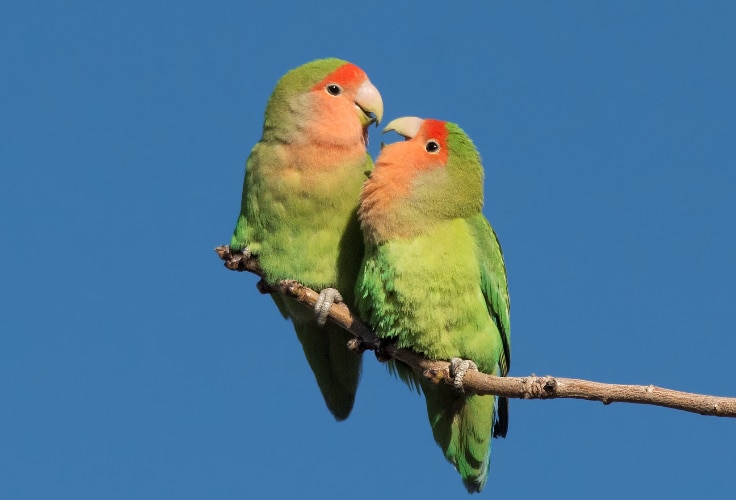
The rosy-faced lovebird is one of the most charming of all parrots. Its compact green body is set off by a bright blue rump, peach-pink face, and expressive dark eyes. The short tail and soft curves of its plumage give it a rounded, toy-like appearance, while its constant chatter and lively movements only add to the impression of an animated little jewel. Captive color forms, such as the yellow lutino or “mango bird,” heighten the cuteness even further with their vivid hues.
These lovebirds are as endearing in behavior as they are in looks. True to their name, pairs perch close together, preening one another and often sleeping side by side with faces turned inward. They are playful, noisy, and highly social, whether in the wild or in captivity. Females sometimes carry nesting material by tucking strips under their feathers like little backpacks, a quirky and comical habit unique to the species. Their constant twittering, acrobatic flights, and strong pair bonds give them a personality that feels almost affectionate toward observers.
In the wild, rosy-faced lovebirds inhabit arid woodlands, rocky hillsides, and tree-lined river courses of Namibia and Angola, always near water. They feed on seeds, buds, and cultivated grains, and often gather in noisy flocks around food sources. While trapping has reduced some populations, especially in southern Angola, the species remains common and adaptable, even establishing thriving feral colonies in cities as far away as Phoenix, Arizona. Its resilience, sociability, and undeniable cuteness ensure its place as one of the world’s most beloved small parrots.
Pink Robin
Petroica rodinogaster
- Why cute: Plump little robin with the male’s striking bubblegum-pink breast against a dark, round body.
- Where found: Breeds in Tasmania, Bass Strait islands, and southeastern Australia, mostly in dense rainforests and wet eucalypt forests.
- Conservation status: Least Concern; locally common but affected by rainforest clearing.
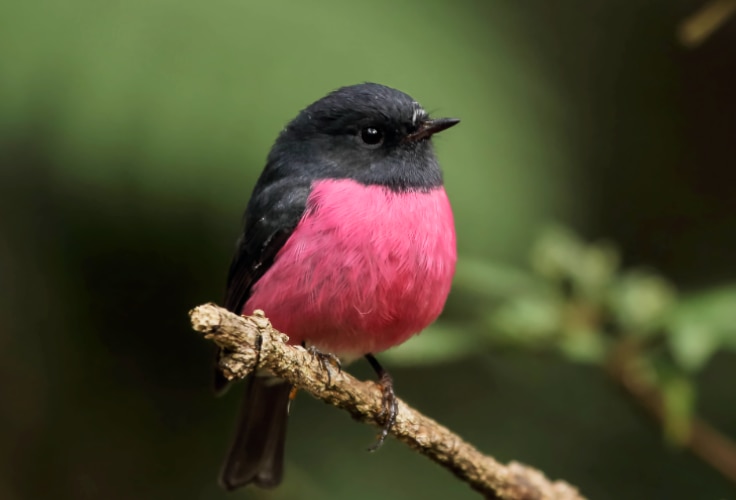
The pink robin is one of Australia’s most striking small birds. The male’s dark head and back contrast with a bright pink chest and belly that look painted on, while females are subtler in warm brown tones with buff patches on the wings. Its compact, round body and short tail make it appear even smaller than it is, giving it a neat, toy-like look that stands out against the shadowy rainforest understory.
Although often shy and quiet, pink robins have endearing behaviors. They flit low among shrubs and mossy branches, gleaning insects or darting out to snatch prey in short flights. Their call, a sharp tick or a quick wren-like trill, is often the first sign of their presence. During the breeding season, they nest deep in shaded gullies, weaving moss-lined cups tucked at the ends of branches, a delicate habit that adds to their secretive charm.
This robin is found in Tasmania, the Bass Strait islands, and wet forests of Victoria and southeastern New South Wales, with some birds dispersing to more open or drier habitats in winter. It remains locally common in much of its range, particularly Tasmania, but has declined in parts of mainland Australia due to clearing of rainforest and wet eucalypt habitat. Despite these pressures, its glowing pink breast flashing through dark forest remains one of the most enchanting sights in southern Australian birdlife.
Adelie Penguin
Pygoscelis adeliae
- Why cute: Compact penguin with wide white eye-rings, tuxedo-like plumage, and comical waddling gait.
- Where found: Breeds on rocky Antarctic coasts and islands; spends winters at sea among pack ice.
- Conservation status: Least Concern; overall population stable or increasing, though some colonies decline with climate change.

The Adelie penguin is often described as the quintessential penguin, with its neat black-and-white plumage, short reddish bill, and large white eye-rings that give it a wide-eyed, cartoon-like expression. Its rounded body and upright stance only heighten the impression of a bird in formal dress, while its small size makes it one of the most approachable and endearing penguins of the Antarctic.
Much of their charm comes from behavior. On land, Adelies waddle in bustling groups, squawking and flapping their flippers with surprising boldness. They court by building pebble nests, often stealing stones from neighbors in a comically sneaky fashion. Despite their size, they are feisty and have been known to chase larger animals, and even pester curious scientists. At sea, their clumsy walk transforms into graceful swimming, with sleek dives and bursts of speed that make them agile hunters of krill and fish.
Adelie penguins are found only in Antarctica, where they form enormous colonies along ice-free rocky shores. They depend on sea ice for foraging and resting, making them true Antarctic specialists alongside emperor penguins. Globally, their numbers remain strong, with millions of pairs, but regional declines are linked to warming seas and shifting ice patterns that reduce access to food. For now, their lively colonies and timeless tuxedo look keep them among the most iconic and undeniably cute birds on the planet.
Goldcrest
Regulus regulus
- Why cute: Europe’s tiniest bird, with a plump body, wide dark eye, and glittering golden crown stripe.
- Where found: Across the Palearctic from Europe to East Asia, in coniferous and mixed forests, also gardens and parks.
- Conservation status: Least Concern; common and abundant, though numbers fluctuate with harsh winters.
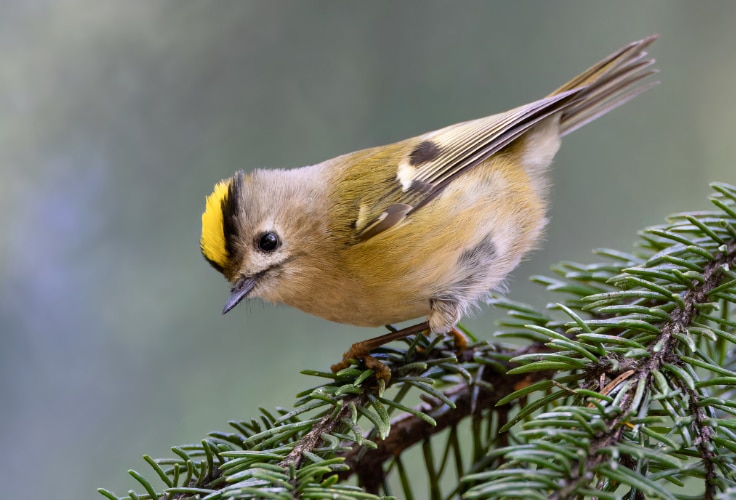
The goldcrest holds the title of Europe’s smallest bird, often barely 9 centimeters (3.5 inches) long, yet it carries itself with the grandeur of a “petty king,” as its scientific name suggests. Its soft olive body is topped with a gleaming yellow crest bordered in black, giving the impression of a tiny crown. The large dark eye and rounded form only heighten its innocent, toy-like look, while the constantly flicking wings make it appear as if it is always buzzing with life.
Its behavior adds to the appeal. Goldcrests flit restlessly among conifer branches, hanging upside down or hovering briefly to pluck tiny insects. Their calls are thin, high-pitched jingles, while the song is a rapid, sparkling trill that seems impossibly bright for such a small bird. In winter, they often join roaming mixed flocks of tits and other woodland birds, their tireless activity making them stand out despite their tiny size.
This diminutive species ranges widely across Europe, Asia, and North Africa, inhabiting spruce and fir forests, laurel woodlands on Atlantic islands, and even conifer plantings in cities and gardens. Populations are generally abundant, numbering in the tens of millions, though they can crash after severe winters when cold and snow limit food supplies. Thanks to their high reproductive potential, they usually rebound quickly, ensuring that the goldcrest remains a familiar, enchanting sight in forests across its vast range.
Rufous Hummingbird
Selasphorus rufus
- Why cute: Minute size, fiery orange plumage, glittering throat, and feisty personality that seems comical in such a tiny bird.
- Where found: Breeds in western North America from the Pacific Northwest to Alaska; winters in central Mexico; common at gardens, feeders, and mountain meadows.
- Conservation status: Near Threatened; populations have declined sharply due to habitat loss and climate-driven changes to flowering cycles.
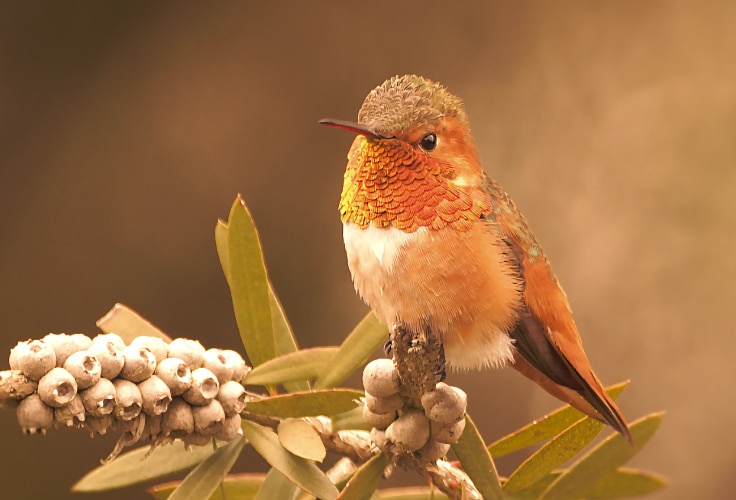
The rufous hummingbird is a pocket-sized jewel, dazzling with its orange-red throat and glowing rufous body. Tiny and delicate, it hovers with rapid wingbeats, suspended in place like a living ember. The contrast between its toy-like proportions and fiery colors makes it one of the most visually striking and endearing hummingbirds.
Cuteness is amplified by its outsized personality. Despite its size, the rufous is notoriously aggressive, fiercely defending flowers and feeders from larger hummingbirds and even small mammals. Its darting flight, glittering throat flashes, and buzzing chases give it a bold, almost comic character. During courtship, males perform looping dives and figure-eight displays, while both sexes are known for their sharp “chip” calls and tail-fanning when agitated.
This species breeds from coastal Alaska and the Yukon south through British Columbia, Washington, Oregon, and into northern California, favoring forest edges, clearings, and gardens. After nesting, it follows a clockwise migration: northward up the Pacific Coast in spring, then south through the Rocky Mountains by late summer, before wintering in the highlands of central Mexico. Increasingly, small numbers also linger in the southeastern United States during winter, often supported by feeders. Once widespread and common, the species has declined in recent decades, largely due to habitat changes and shifts in flowering cycles tied to climate warming.
Snowy Owl
Bubo scandiacus
- Why cute: Round, fluffy body, soft white plumage, striking yellow eyes, and a calm expression that can appear faintly smiling.
- Where found: Breeds on Arctic tundra across North America and Eurasia; winters south into Canada, northern U.S., and occasionally northern Europe and Asia, favoring open fields, dunes, and coasts.
- Conservation status: Vulnerable; populations fluctuate with prey cycles but show long-term declines linked to climate change and habitat shifts.
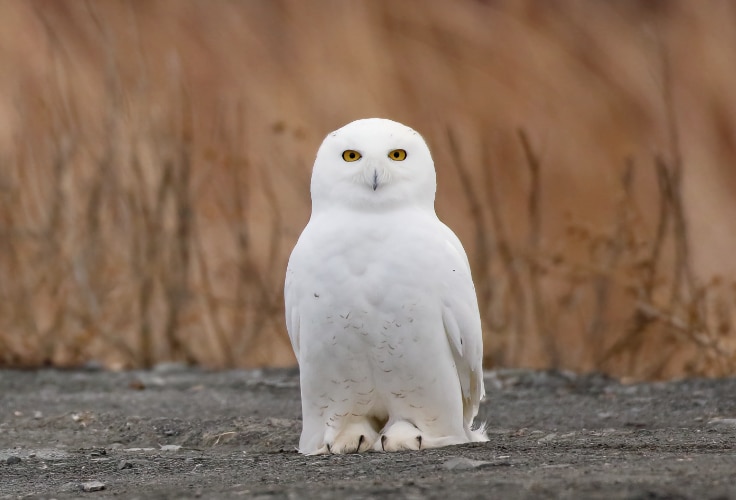
The snowy owl is instantly recognizable as one of the world’s most striking owls, with its gleaming white feathers and oversized round head. Its dense plumage makes the bird look soft and plush, while its large yellow eyes and rounded facial disc give it a calm, almost smiling expression. Perched on a windswept dune or field, it appears both regal and endearing, a living emblem of the Arctic.
Much of its charm comes from its unusual habits. Unlike most owls, the snowy owl is diurnal, often sitting motionless in plain sight for hours, swiveling its head with a curious, almost comical intensity. When hunting, it pounces suddenly on prey, sometimes even running across the ground to catch small mammals. Males perform courtship flights with exaggerated wingbeats, often carrying a lemming as a gift, before bowing with fanned tails. Their fierce defense of nests and winter territories adds to their bold, charismatic personality.
The species breeds across the High Arctic tundra of North America and Eurasia, closely tied to lemming populations. In winter, it disperses southward, appearing on coasts, grasslands, and farmlands, with some years bringing dramatic irruptions far into the United States and occasionally into Europe. Though still widespread, snowy owls face pressures from climate change altering prey cycles and snow cover. Their numbers rise and fall with rodent booms, but long-term declines have placed them among the most conservation-sensitive Arctic raptors.
European Robin
Erithacus rubecula
- Why cute: Plump round body, bright orange face and breast, and lively, alert expression.
- Where found: Across Europe, western Asia, and parts of North Africa in woodlands, hedgerows, farmland, parks, and gardens.
- Conservation status: Least Concern; widespread and abundant, with stable populations overall.
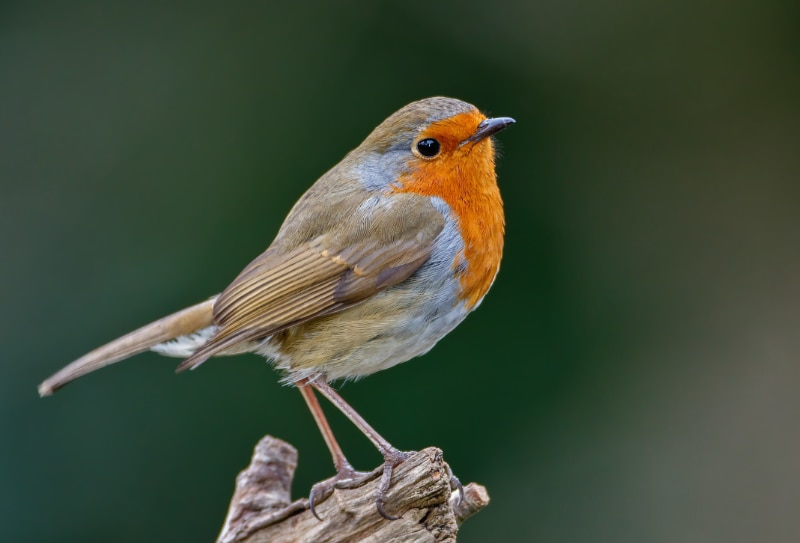
The European robin, often called “robin redbreast,” is one of the most familiar and beloved small birds in Europe. Its compact, rounded form and glowing orange breast stand out against its otherwise soft olive-brown plumage, creating a charming contrast. With large dark eyes and a posture that makes it look both upright and curious, it has become an enduring cultural symbol, appearing on Christmas cards and decorations for over a century.
Much of its cuteness lies in its bold, inquisitive behavior. Robins often hop perkily across lawns or garden beds, flicking their wings and cocking their tails as they forage. They famously follow gardeners, darting close to overturned soil to snatch worms and insects, a habit that makes them seem unusually tame. Their varied, silvery song brightens even cold winter days, while their sharp “tic” calls and occasional scuffles reveal the feisty, territorial side of their character.
The European robin occurs from the Mediterranean and North Africa northward through Europe into Scandinavia and Russia, extending east to Iran. It thrives in woodland edges, thickets, hedgerows, and urban parks, favoring shaded areas with cover and open patches for foraging. Western populations are mostly resident, while northern and eastern birds migrate south in winter. Abundant and well-adapted to human landscapes, the robin remains one of the most stable and widespread songbirds across its range.
Tufted Titmouse
Baeolophus bicolor
- Why cute: Big dark eyes, small rounded bill, gray crest, and perky, active movements.
- Where found: Eastern and southeastern United States and parts of northeast Mexico, in deciduous forests, mixed woodlands, suburbs, and gardens with mature trees.
- Conservation status: Least Concern; populations stable and expanding northward, aided by feeders and regenerating forests.
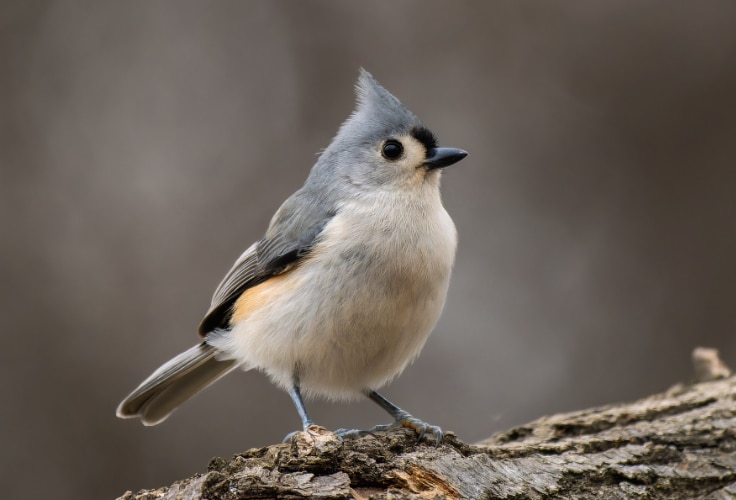
The tufted titmouse is a compact, gray-plumed songbird with a pointed crest and oversized black eyes that give it a bright, eager expression. Its rusty flanks add a warm splash of color, and the way it tilts its head while scanning its surroundings makes it look alert and inquisitive. Small and lively, it is a year-round fixture at backyard feeders across much of the eastern United States.
Part of what makes it endearing is its constant activity. Tufted titmice flit nimbly through branches, hanging upside down to probe for insects, or dropping to the ground in quick hops. They crack sunflower seeds with sharp blows of their bill and often cache food in bark crevices for later. Their clear “peter-peter-peter” whistle carries through the woods, and they readily join mixed flocks of chickadees, nuthatches, and woodpeckers. Despite their small size, they can be bold, even tugging hair from animals to line their nests.
The species inhabits deciduous and mixed forests, riparian woodlands, and wooded suburbs across the eastern U.S., reaching into parts of northeast Mexico. Once more restricted in range, it has expanded steadily northward over the past century, a trend linked to reforestation and the spread of bird feeding. Widespread and increasing, the tufted titmouse is a common and secure part of eastern woodland bird communities.
Cuban Tody
Todus multicolor
- Why cute: Tiny, round-bodied bird with a large head, glowing green plumage, red throat, and pink flanks.
- Where found: Endemic to Cuba and nearby islands, in forests, thickets, plantations, and mangroves.
- Conservation status: Least Concern; widespread and common, though local populations may be vulnerable on small cays.
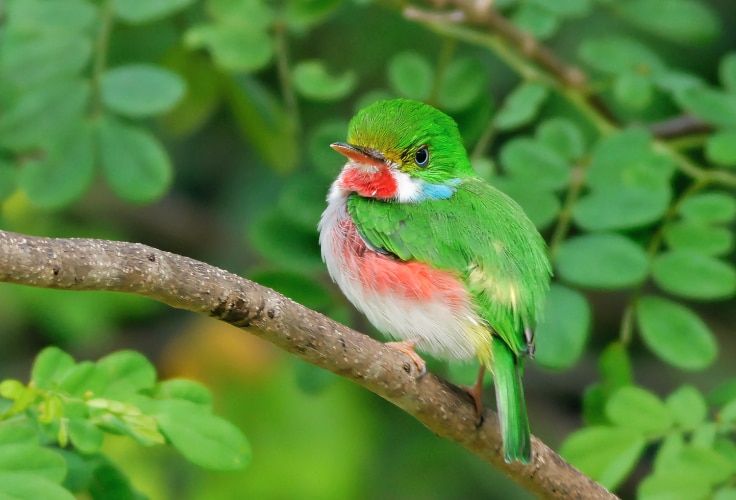
The Cuban tody is a living jewel, with shimmering green upperparts, a brilliant red throat, and soft pink flanks. Its oversized head and short tail give it a comical, big-headed silhouette, while its gleaming colors make it one of the most striking small birds in the Caribbean. Barely larger than a golf ball, it is often described as looking like a toy come to life.
Its cuteness is amplified by constant activity and endearing behaviors. Cuban todies are almost always seen in pairs, perching low in the forest and suddenly leaping up to snatch insects from leaves. They give frequent rolling trills and sharp “chuk” calls, while their red throat feathers bristle with each note. Often tame and approachable, they sit still for long moments before bursting into quick, energetic sallies, their round little bodies flashing with color.
This species is found across Cuba, including the Isle of Pines and many offshore cays, where it inhabits a wide variety of wooded and semi-wooded habitats. It adapts well to forests, plantations, thickets, and mangroves, particularly in areas with clay embankments for nesting burrows. Though widespread and secure overall, localized threats such as pesticide spraying on smaller islands can impact populations. For now, the Cuban tody remains one of the island’s most abundant and enchanting birds.
Atlantic Royal Flycatcher
Onychorhynchus swainsoni
- Why cute: Big-headed look, long bill, and spectacular fan-shaped crest that creates a comical yet dazzling appearance.
- Where found: Endemic to the Atlantic Forest of southeastern Brazil, in humid lowland and montane forests, especially along shaded streams.
- Conservation status: Vulnerable; rare and declining due to severe habitat loss and forest fragmentation.
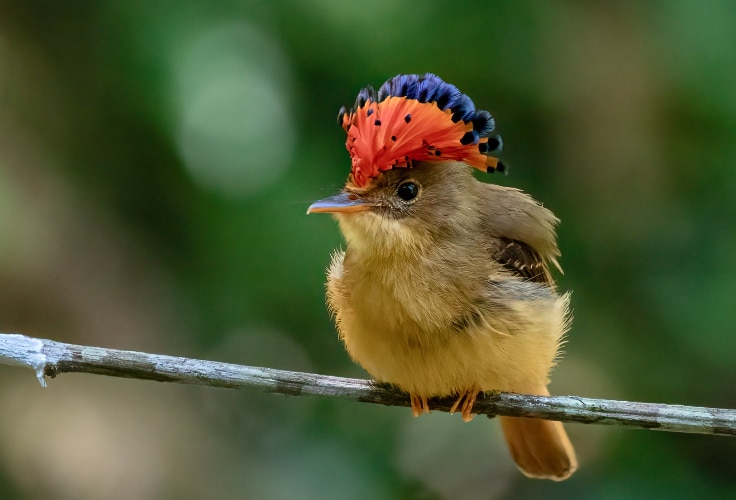
The Atlantic royal flycatcher is a curious-looking bird with a flat-headed profile and long bill, usually appearing rather plain brown until it raises its extraordinary crest. When spread, the feathers form a radiant semicircle of red or orange with blue-black tips, a sudden burst of color on an otherwise modest frame. The contrast between its big-headed silhouette and dazzling fan makes it one of the most surprising and charming flycatchers.
Its cuteness is heightened by its shy, quiet manner. These birds usually perch low in the forest, sitting still for long periods before fluttering up to snatch insects from foliage. They call with a sharp, squeaky “yeeek!” or give soft whistles, often while keeping their crest flat. During nesting, the crest is more often displayed, adding drama to their otherwise subdued habits. Their oversized, dangling nests – long bundles of plant fibers suspended over streams, only add to their unusual charm.
This flycatcher species is confined to the Atlantic Forest of southeastern Brazil, from Bahia south to Santa Catarina, where it inhabits evergreen and mixed forests at low to mid elevations. Always scarce and localized, it is now threatened by ongoing deforestation and fragmentation that has left its population small and isolated. Once hunted for its ornate crest feathers, the Atlantic royal flycatcher remains one of the most vulnerable and elusive jewels of Brazil’s forests.
Red-Backed Fairywren
Malurus melanocephalus
- Why cute: Tiny, round-bodied bird with a cocked tail, bright red back in males, and perky, restless movements.
- Where found: Endemic to northern and eastern Australia, in grasslands, savannas, wetlands, and shrubby edges, often near human settlements.
- Conservation status: Least Concern; common across its range, though sensitive to wildfire impacts.
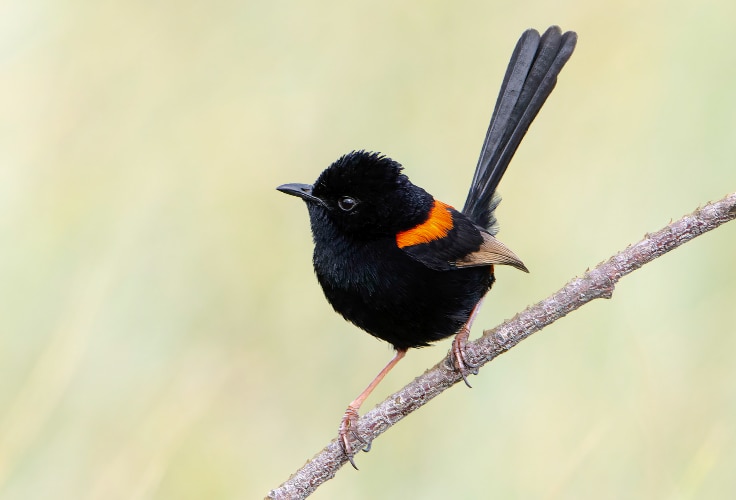
The red-backed fairywren is one of Australia’s smallest songbirds, instantly catching the eye with its compact body, long upright tail, and vivid breeding plumage in males. Adult males glow jet black with a fiery red or orange back, while females and young birds are soft brown with pale underparts, blending into the grasses where they live. Their round form and constantly flicking tails give them an irresistibly sprightly look.
These fairywrens are endlessly active, hopping through grass and low shrubs with quick, jerky movements and occasional short flights. Males put on elaborate courtship shows, puffing out their red back feathers until they look like little balls of fire, sometimes even presenting flower petals or bright objects to females. Outside of displays, the species charms with its duets, frequent contact calls, and close pair bonds, with mates often huddling and preening together. Their habit of forming small family groups, occasionally with a helper from a previous brood, adds another layer of endearing social behavior.
The species is widespread across northern and eastern Australia, where it thrives in open savannas, wetlands, and grassy scrub, including gardens and roadsides. Though populations are generally stable, studies show they can decline sharply after intense wildfires. Despite this, the red-backed fairywren remains abundant and adaptable, one of the most familiar and delightful small birds of the Australian landscape.
White-Browed Tit-Warbler
Leptopoecile sophiae
- Why cute: Tiny, round bird with a chestnut cap, pale brow, purplish-blue back, and soft pink belly.
- Where found: High-altitude scrub and forests from Central Asia and the Himalayas through western China, descending to foothills in winter.
- Conservation status: Least Concern; locally common though vulnerable to habitat loss and harsh winters in parts of its range.
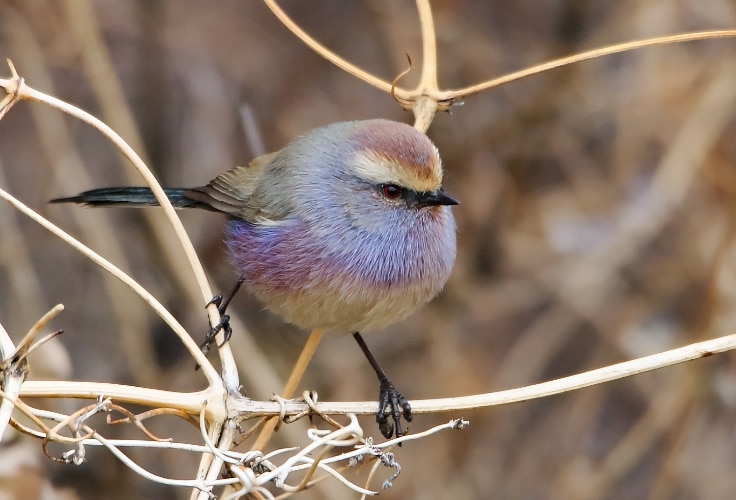
The white-browed tit-warbler is often described as one of the world’s most jewel-like birds. Barely larger than a ping-pong ball, it combines shimmering purplish-blue upperparts, a warm chestnut crown, and a soft pink wash on the underparts. Its pale eyebrow adds a gentle, wide-eyed look, making the bird appear almost painted in pastel tones. The contrast of vivid colors on such a tiny, round frame creates an irresistible charm.
Its cuteness is enhanced by restless and social behavior. These birds flick their long tails as they hop through alpine shrubs, often foraging close to the ground or hanging briefly upside down to pick insects from leaves. After the breeding season they form family parties that sometimes merge into small flocks, chattering softly as they move through juniper and rose thickets. Their high, crisp calls give them an excitable air, while in courtship males may sing quiet, whispery songs to their mates.
This species inhabits montane scrub and subalpine forests from the Tian Shan and Himalayas east into western China and Tibet. It breeds at high elevations, often above the tree line, and winters in lower valleys where it favors dense thickets of sea-buckthorn and willow. While not globally threatened, populations can fluctuate sharply after severe winters, and overgrazing and shrub loss may reduce suitable habitat in parts of Central Asia. Despite these pressures, the white-browed tit-warbler remains one of the most enchanting small birds of the Asian highlands.
Finding Cuteness Nearby
While penguins and snowy owls may live far away, many of the cutest birds such as tits, robins, chickadees, and titmice can be seen just outside the window. Their round forms, bright songs and lively antics bring charm to everyday moments and remind us that nature’s most endearing creatures are often the ones closest to home.

